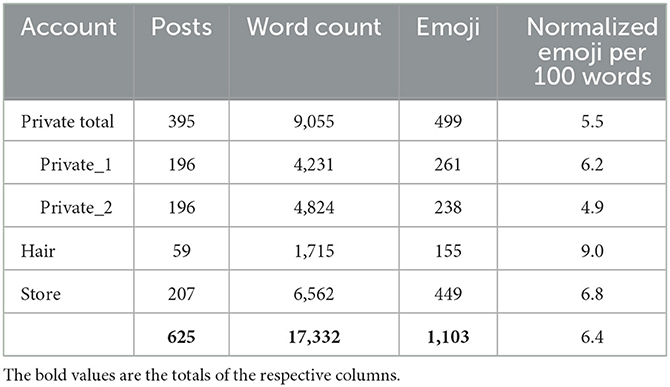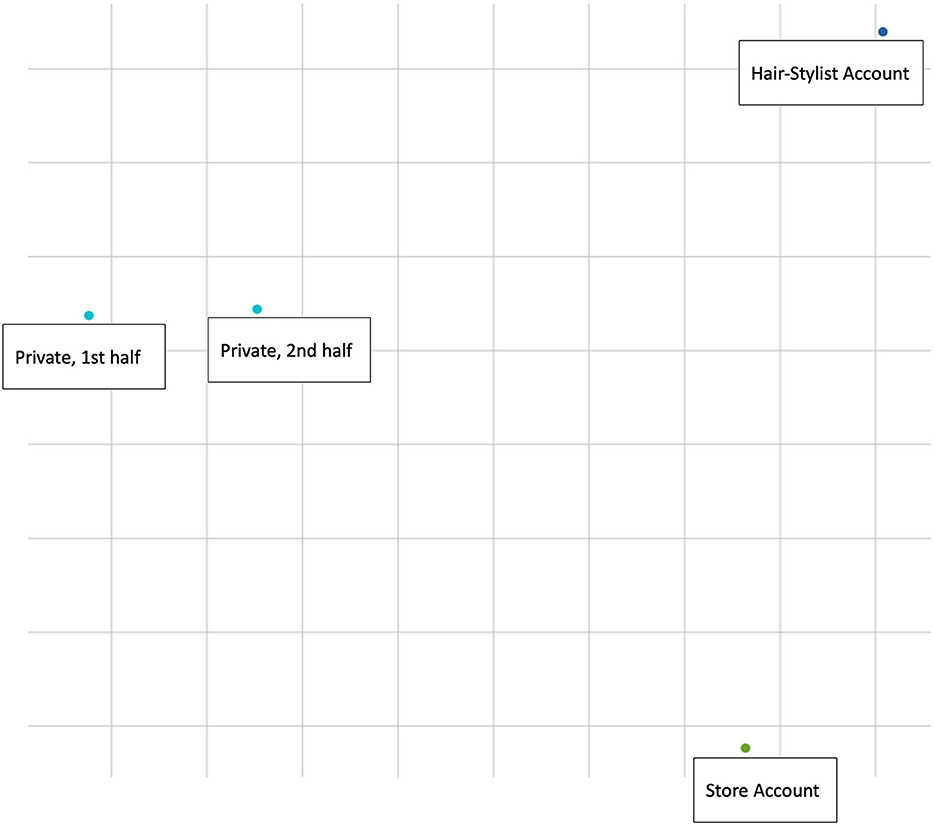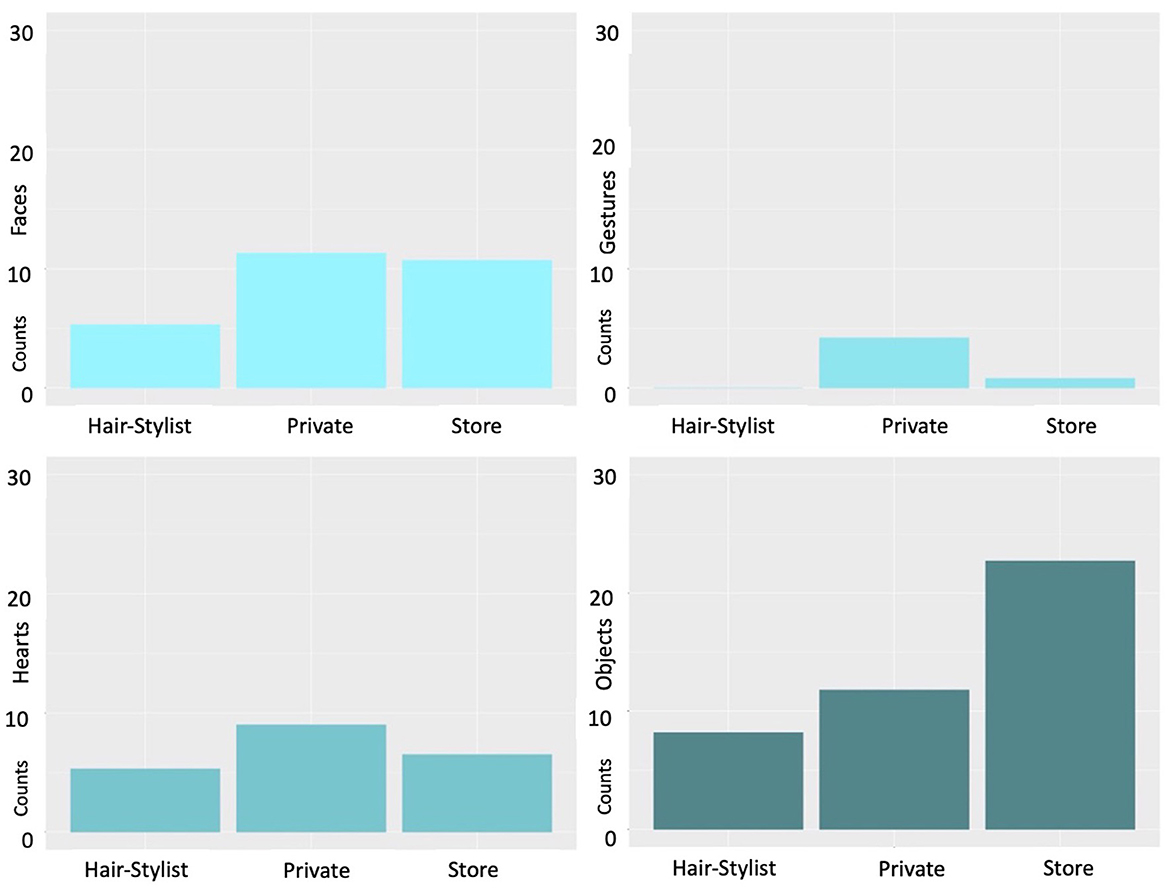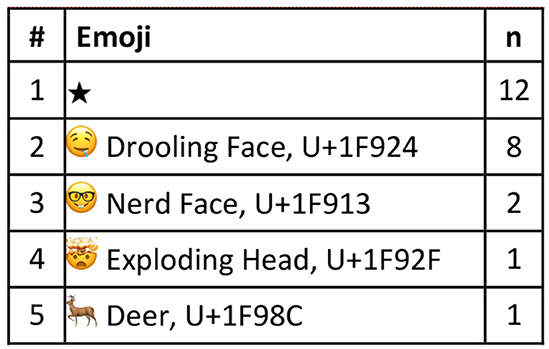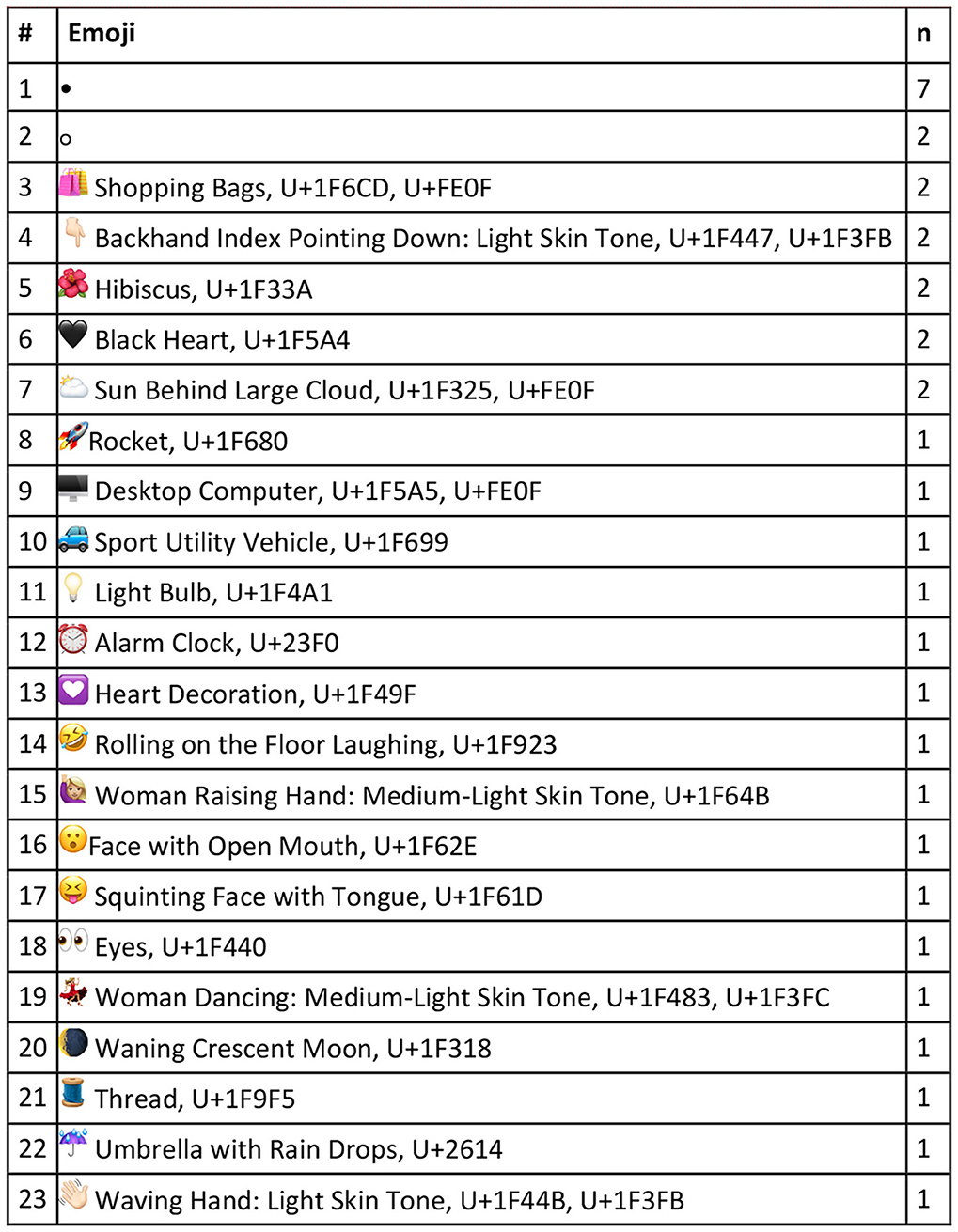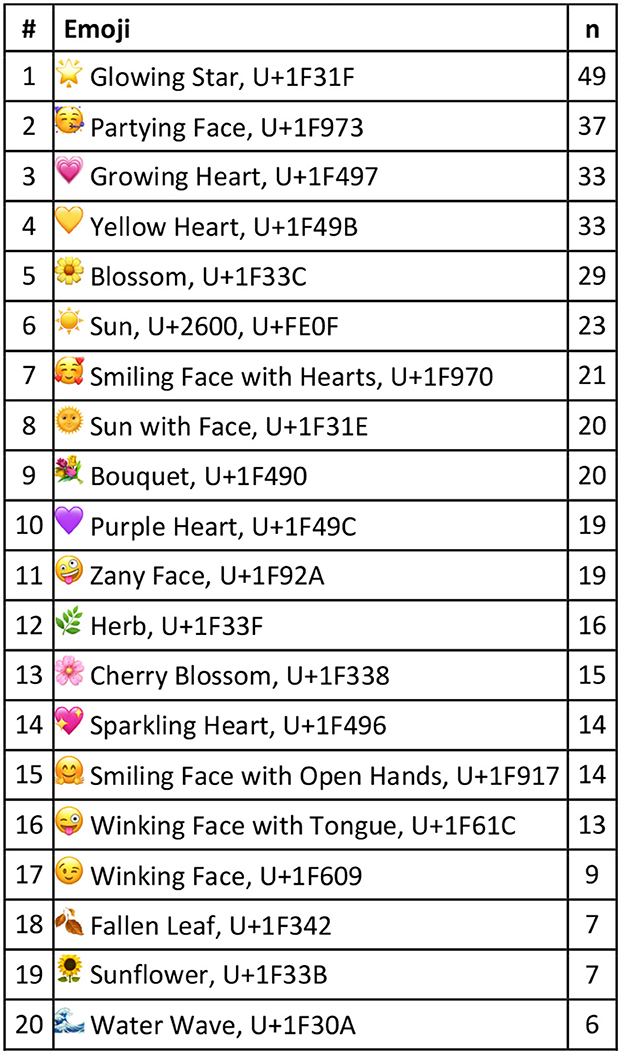- Institute of English Studies, University of Graz, Graz, Austria
Introduction: Emoji are omnipresent features of digital discourses and have become almost inherent features of online interactions. Given the large and ever-increasing variety of emoji, it is not farfetched to assume that users will have preferences for particular emoji or emoji combinations, and that their preferences are indexically related to their identities, for example in terms of skin-tone and/or gender. With a case study, the present paper aims to address a particular gap in the extant literature, namely the role of emoji in the presentation of different identities of one individual, namely a US American female in her early 20s.
Methods: The data for this study was drawn from Instagram and comprises a total of 625 posts made by one user to three of her own accounts with the platform. Each account represents a different aspect of her identity, and the analysis demonstrates that while the use of some emoji remains stable across all of her accounts, other emoji are very account-specific in that they are employed to highlight one particular aspect of her identity.
Results: The results thus indicate the different values that emoji might have in the contexts of authorship analyses. Additional studies are required to investigate this phenomenon further.
1. Introduction
People constantly present different aspects of their identities in their daily interactions with other people. For example, in interactions with friends, a person is likely to show a different self-identity compared to interactions with parents, siblings, teachers, or strangers (Bell, 1985). Thus, the concept of “identity” is a highly complex one and depends not only on person-internal features but also varies with respect to contexts, situations, and individuals involved in interactions (see, for example, Bell, 1985). Wheeler and Bechler (2021) argue that “identities are categorical labels” (p. 6) that can be percieved of as a collection of beliefs (Sparks and Shepherd, 1992) and that can be differentiated according to whether they reflect personal identity or social identity (Guimond et al., 2006). Elements that contribute to a person's identity are personality traits, physical characteristics, social relationships, or group affiliations, among others. While individuals place themselves into some of these categories, other categories are assigned to them from the outside (Wheeler and Bechler, 2021). Individuals further draw on different aspects of their identity, depending on the respective situation, meaning that they highlight certain parts of their identity while they background or sideline others, as perceived appropriate by the contextual elements of the interaction (see, e.g., Grant and MacLeod, 2020).
The performance of identity or identities has been discussed in particular by Goffman (1959) in their seminal work The presentation of self in everyday life. Goffman (1959) has compared social interactions with a performance and has argued that a performance is an “activity of an individual which occurs during a period marked by his continuous presence before a particular set of observers” (p. 22). From this perspective, individuals are seen as actors who perform for a particular audience (Robertson et al., 2018). Goffman (1959) further distinguishes a front stage in which individuals aim to present an idealized version of themselves, from a more private backstage. In the context of the present paper which focuses on the portrayal of identities in an online environment, it is important to acknowledge that although many researchers do consider social media platforms to be rather public spaces (Zappavigna, 2012; Page et al., 2022), others consider this matter far from resolved (Stevens et al., 2015). In this paper, however, social media platforms are regarded to be rather public spaces for identity performances, particularly if access to posts is not restricted to a specific audience. A major difference between on- and offline perfomances is that in contrast to an unrecorded stage performance or offline conversation, an online performance is often retained and stored, thereby making it available for a future audience (Hogan, 2010) that might not be the target audience of the user. The specificities of online identities will be discussed subsequently.
1.1. Online identities
In an online environment, the question arises as to which degree the online identity reflects the offline identity (Robertson et al., 2018), i.e., how closely the online representation of the individuals' identity matches or resembles their offline identity. Robertson et al. (2018) argue that for some individuals, the correspondence between on- and offline identities is higher than for others based on their desire to represent their “real” self. In contrast, some online identities might be “at odds with reality” (p. 2), which implies that some individuals are performing a role that they do not embody offline. However, as Reed (2005) states, it is likely that an online profile “signifies a single individual [and] does not merely stand in for that individual but is that individual” (Hogan, 2010, p. 380). It is particularly young adults and late adolescents who experiment with the presentations of their online identities, as a study by Jordán-Conde et al. (2014) has demonstrated, and which is directly relevant in the context of the present study.
Robinson (2007) has coined the term “cyberperformers” in an effort to account for online identity performances, which requires adaptations of the original concept for the reason that online identity presentations differ from offline ones with respect to several features. For example, it is specific to the virtual world that it combines aspects of both offline and online performances (Hogan, 2010). As hinted at above, digital performances are often for unidentified audiences, are archived for future audiences, and, in addition, might not even take place synchonously (i.e., with the performer and their audience online at the same time). Social media platforms in particular have been found to be ideal front stages for identity performances (Ge-Stadnyk, 2021). Importantly, however, Tracy and Robles (2013) argue that cyberperformers have to keep a more diverse audience in mind than offline performers, who are usually aware of who is listening to them. Online, in contrast, a cyberperformer has less, if any, influence over who will view their social media sites and interact with (i.e., like, view, share, comment on etc.) their posts. Furthermore, online identity performance differs from offline identity performance, because individuals have an additional array of digital affordances available for their communication, including emoticons and emoji (Ge-Stadnyk, 2021), which can subsitute for gestures, provide insight into emotions of the user, or add illustrations of what has been stated in the accompanying text. Addtionally, partiularly with respect to Instagram, emoji might also be used to reflect the picture that they are posted with (Marko, 2022a).
1.1.1. Instagram
Instagram is a popular social media platform whose main purpose it is to share pictures with one's followers or, in the case of public profiles, with a vast unidentified audience. In contrast to other social media platforms, Instagram does not allow the sharing of posts without a picture (unless the picture file that is uploaded contains text) and is thus heavily multimodal in nature (Leaver et al., 2020). Only few linguistic analyses have addressed the language on Instagram, such as Manovich (2017), Veum and Undrum (2018), Siever and Siever (2019), Marko and Sullivan Buker (2022), and Marko et al. (2022). Leaver et al. (2020) further point out that the platform is mostly used for self-presentation, which is why Instagram is the ideal platform for identity-related research.
1.2. Emoji as markers of identity
Emoji, which are picture characters (Goldman, 2018) that have been available for easy use on Apple iPhones only since 2011 (Evans, 2017) and for Android phones since 2013 (Cervantes, 2018) when a special emoji keyboard was introduced (Dimson, 2015), are popular multimodal features of digital interactions. As of 2021, 3,633 different emoji are codified by the Unicode Consortium (Emojipedia, n.d.) and are used with tremendous frequencies in digital communications. For instance, it is estimated that over six billion emoji are sent on social media platforms every day (Evans, 2017) and that half of all comments made to Instagram contain emoji (Dimson, 2015). In 2015, additional features such as skin-tone modifiers and more gender-sensitive options have been introduced (Robertson et al., 2020). These modifications allow users to select emoji that represent them more accurately than their previous, purley yellow but more neutral counterparts.
In order to demonstrate how intricately linked emoji and identity seem to be in the minds of their users, a case example will serve as illustration: In 2017, Kendall Jenner posted a message on Twitter that included an emoji fist that was one shade darker than the white emoji. Jenner's use of this skin tone was perceived to be racist by many Twitter users who argued that Jenner could not use this skin tone as she was not black. This incident, as reported by Halverson (2021), shows that in the minds of many users, there is a “robustly presupposed relationship (iconic or symbolic) between an emoji and its user” (p. 2). This seems to be the case particularly for skin tones (Robertson et al., 2020, 2021; Halverson, 2021) and for gender (Halverson, 2021). Evidence for an indexical relationship between individuls and emoji used in self-descriptions on Twitter has also been found (Li et al., 2020). Further, a study by Ge-Stadnyk (2021), for example, indicates that emoji use is also culture-specific. For instance, some emoji represent culturally specific actions and objects that are not understood (and used) in the same way by individuals with other cultural backgrounds. Li et al. (2020) further argue that the used emoji “reveal important aspects of [users'] self-identites, such as the teams and musicians that they support, the activities they enjoy, their national and political identities, and show their similarities with their followers in these same aspects” (p. 206–207). Thus, it can be assumed that emoji are essential features of online self-presentations (Ge-Stadnyk, 2021) that can be employed to portray both personal and group level identities and affiliations.
What most of the studies outlined above have in common is that they investigate how emoji are related to an author's identity performance on one platform or account. The research gap the present paper attemps to address is the lack of investigations of a single individual's portrayal of different aspects of their identity through emoji on different accounts with the same social media platform. Thus, the following research question has been developed for this study: How, if at all, does the use of emoji represent different aspects of one user's identity on thematically different Instagram accounts?
2. Data and methodology
The data for this study was collected in the winter of 2021/22 from the social media platform Instagram. At this stage of research, it was refrained from including accounts from other social media platforms of the same user into the analysis in order to preclude any effects excerted on the emoji use by platform-dependent requirements or platform-specific affordances (Marko et al., 2022). Future research, however, might consider cross-platform identity performance through emoji as well. The individual whose data is included in this analysis is a US American female in her early 20s with a bachelor's degree, who holds three different accounts with the platform, and who was identified as a suitable subject for this paper through a previous study (Marko, 2020). The individual's accounts are put to different uses, i.e., one is her personal account, one is used for her job as a hair stylist, and the third account is used for the promotion of her own store selling clothes. The name of the user will not be revealed, but for convenience, the individual will be referred to as Amanda throughout the study. The corpus includes 625 posts, 17,332 words, and 1,103 emoji. An overview of the corpus is provided in Table 1.
After the data collection, the emoji in the dataset were coded with the software MaxQDA (VERBI Software, 2022). In order to illustrate how the coding was employed, an example will be provided below:
Example (1) I love butterflies!! 
In Example (1), the butterfly was coded as “ Butterfly, U + 1F98B.” The ID following the name of the emoji is attributed to all emoji by the Unicode Consortium, which makes the coding process as objective as possible. The IDs are provided throughout the paper in order to make the emoji uniquely identifiable, despite the different renderings of the same emoji on different devices and platforms (e.g., Miller et al., 2016, 2017; Evans, 2017; Goldman, 2018).
Butterfly, U + 1F98B.” The ID following the name of the emoji is attributed to all emoji by the Unicode Consortium, which makes the coding process as objective as possible. The IDs are provided throughout the paper in order to make the emoji uniquely identifiable, despite the different renderings of the same emoji on different devices and platforms (e.g., Miller et al., 2016, 2017; Evans, 2017; Goldman, 2018).
2.1. Mock authorship analysis
In order to answer the proposed research question, a mock authorship analysis was set up. An authorship analysis aims at comparing the texts of two or more authors in order to determine whether the employed writing styles are similar or different (e.g., Coulthard, 2004; Fobbe, 2011). In a forensic context, this kind of analysis aims to reveal whether an anonymous text exhibits a writing style that is more similar to person A's or to person B's writing styles (both of whom might be suspects in a criminal matter, for example).
For the purpose of the mock authorship analysis in this paper, the chronology of the posts of the private account was randomly scrambled with the aim of preventing an influence of seasonal or other time-related differences or biases in the display and use of emoji. After scrambling the posts, they were separated into two sets of documents, each set amounting to 196 posts. In the next step, all emoji in the four datasets (the Hair-Stylist Account, the Store Account, and two parts of the Private Account) were coded as outlined above (see Example 1). Emoticons were excluded from the analysis due to their low frequency in the corpus, even though a previous study has indicated that emoticons, which are created with regular ASCII characters, might have a higher potential in discriminating between authors than emoji (Marko, 2022b). After the coding, Jaccard's Coefficient (see, e.g., Grant, 2013) was used to calculate distances between the posts on the different accounts. The separation of the data from the personal account into two datasets aids in establishing whether the emoji on the personal account are more similar to each other compared to the other two accounts with the help of Jaccard's Coefficient and a similarity map created by MaxQDA based on the list of codes.
2.2. Jaccard's coefficient
Jaccard's Coeffient is a statistical means to measure distances between texts (MacLeod and Grant, 2012; Grant, 2013). Essentially, it is a binary measure (i.e., it takes into account either absence or presence of a feature) that indicates how similar or different the compared texts are with respect to the investigated features. Grant (2013, p. 482) argues that it is an
advantage of Jaccard […] that it does not inflate similarity on the basis of two absences. Absence of evidence of a stylistic feature in a particular text message is not evidence of its absence from that individual's stylistic range […] and thus using Jaccard does not risk overstating the explanatory power of a single text.
Several scholars have previously demonstrated the usefulness of Jaccard's Coefficient in forensic authorship analysis, particularly in the context of short texts (MacLeod and Grant, 2012; Grant, 2013; Marko, 2020, 2022b), which is why this measure is also adopted in the present paper. Jaccard's Coefficient was calculated with the software MaxQDA, which also creates a multidimensionally scaled map that visualizes the distances between the investigated textual material in terms of the selected features. In the present analysis, only the types of emoji were investigated, as previous studies had suggested that the types of emoji might be more promising features as markers of identity than the functions of emoji (Marko, 2020, 2022b). However, future studies might also consider emoji functions (such as complementation, substitution, reinforcement, and contradiction) in terms of identity performance, since this is another gap in the extant literature.
2.3. Limitations
The present paper presents the analyses of a case study and thus comprises only 17,332 words and 1,103 emoji. However, the dataset itself is unique in that, to my knowledge, it has not yet been attempted to describe the use of emoji of one person on the same platform but for different accounts with the platform and with respect to their identity management on these accounts. Therefore, despite the small sample, the analysis can point toward valuable aspects for future investigations and can contribute to furthering our knowledge about emoji, digital discourse, and authorship analysis.
2.4. Ethical considerations
The data included in this study is taken from public accounts, which means that anyone with access to Instagram can view the posts. However, since it has been debated whether social media sites are public or private spaces (Stevens et al., 2015) and even though Instagram allows the use of data for third parties and researchers (Instagram, 2018), the name of the individual whose data is included in the study has been anonymized to protect her identity. Also, in order to keep the possibility of reverse identification through search engines to a minimum (Ayers et al., 2018), the wording of the posts in any of the given examples has been changed in line with previous researchers (Ayers et al., 2018; Gawne and McCulloch, 2019), as the precise wording does not add an additional value to the present study.
3. Analysis and results
The analysis will be presented in two parts: firstly, the results of the statistical analysis with Jaccard's Coefficient will be described. Secondly, with the aid of prior statistical tests, a more qualitative approach is taken with the detailed description of the emoji use and the explanations for their use on the three different accounts.
3.1. Measuring textual distance with Jaccard's coefficient
After the coding of the emoji in the dataset, the distances between the texts on the accounts were measured with Jaccard's Coefficient. Table 2 depicts the results of this analysis. The closer a value is to 1, the more similar the texts are; the closer a value is to 0, the more different the texts are in terms of the investigated features (i.e., emoji).
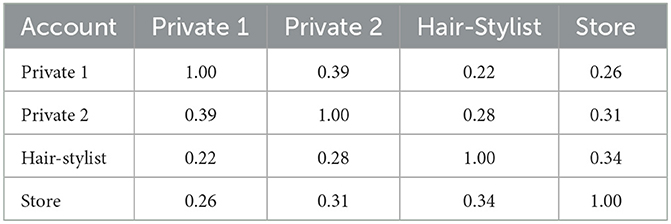
Table 2. Distances between the investigated texts based on emoji use and calculated with Jaccard's Coefficient.
Figure 1 visualizes the distances between the investigated texts and also shows that the two parts of Amanda's Private Accounts cluster closer to each other than to her Hair-Stylist and Store accounts. Interestingly, the Hair-Stylist and Store accounts, both of which serve the purpose of selling either goods or services, do not cluster closely together, either. This finding is a first hint at the fact that Amanda's use of emoji is different on her three accounts, suggesting that the used emoji do play a role in the presentation of her identities and do not solely reflect the purposes of the accounts. In terms of an authorship analysis, this finding would be considered a correct attribution (i.e., the second half of the data of the Private Account was attributed correctly to the first part of the Private Account rather than to any of the other two accounts). However, this finding in and of itself does not reveal any information about the nature of emoji and about how the emoji are employed in the presentation of her identity (or identities). In order to find out more about this issue, a qualitative analysis is undertaken, the results of which will be reported below.
3.2. Analysis of types of emoji
As a first step, the overall use of emoji on the separate accounts will be looked at in order to determine whether it is possible to derive any usage patterns from them. For this analysis, the emoji were grouped into the following categories, based on other classification systems, such as the ones employed by Apple iOS16: faces, gestures, hearts, and objects. This classification was chosen as it is very practical and easy to use with little ambiguity. Figure 2 shows that the emoji in these categories are distributed unevenly across the accounts. To test whether the differences are also statistically significant, a generalized linear model with Poisson distribution was run in R (R Core Team, 2022). Additionally, a dispersion test was used, which provided no indications of over-dispersed data and therefore, the Poisson distribution rather than a quasi-Poisson distribution was used for the generalized linear model. Also, post-hoc tests with simple contrasts were run, and the following results were obtained: with respect to face emoji, significant differences exist between the Hair-Stylist and the Private as well as the Hair-Stylist and the Store Accounts (both with p < 0.001); gesture emoji appear significantly more frequently on the Private than on the Store Account (p < 0.001); heart emoji are significantly more common on the Private Account compared to the Hair-Stylist Account (p < 0.001), and significantly less common on the Hair-Stylist Account than on the Store Account (p < 0.001); lastly, object emoji appear significantly more often on the Private Account than on the Hair-Stylist Account (p = 0.02), but significantly less often than on the Store Account (p < 0.0001). Also, the Store Account contains significantly more object emoji than the Hair-Stylist Account (p < 0.001).
In order to investigate the emoji use in more detail, however, the emoji that are specific to the respective accounts are separated from those that appear on more than one account, and from those that appear on all accounts. For a first overview, the same statistical tests as outlined above (generalized linear model with Poisson distribution and post-hoc test with simple contrasts) were conducted for the emoji that are exclusive to the three investigated accounts. The following significant results were obtained: A difference exists between the Private and the Store Account in terms of face emoji (p = 0.0005), gesture emoji (p < 0.001), heart emoji (p = 0.029), and object emoji (p < 0.001); as well as between the Hair-Stylist and the Private Account for object emoji (p < 0.001).
In order to arrive at a better understanding of these differences, a closer look will be taken at the emoji that Amanda uses exclusively with her Private Account. Table 3 provides an overview thereof.
Table 3 shows that 110 emoji types are unique to Amanda's Private Account, which means that it is her Private Account on which she displays the largest range of overall emoji use. However, it is also visible that 70 of the 110 emoji (i.e., 63.3%) appear only once, and only 18 (i.e., 16.4%) appear more than twice. The two most frequent emoji specific to Amanda's Private Account are used five times in the dataset, which account for 9.1% of all emoji.
The most frequently used emoji on Amanda's Personal Account are emoji relating to or showing emotion, while the least frequent ones represent objects. In contrast, on her Hair-Stylist Account (see Table 4), it is a rather unusual multimodal marker, a black star, that is the most frequent emoji, followed by three face and an animal emoji. Even though the star is not technically considered an emoji as it does not have a Unicode ID, it is still considered as such in the present analysis as it is clearly a multimodal object that is not created with existing keyboard characters (as emotions are, for example). However, a closer look at the data shows that the black star is indeed overrepresented and an outlier, as it appears 12 times in total, but only within one post. In this one post, the star is used instead of bullet points within a list.
The second most frequent emoji, which, in contrast to the black star, appears in five different posts, is the Drooling Face (U + 1F924). Examples (2) and (3) show how it is used in the dataset:
Example (2): I love creating this 
Example (3): Just the right amount of blend 
Similar to the emoji used on the Hair-Stylist Account, the most frequent emoji on Amanda's Store Account (see Table 5) are also not typical emoji with a Unicode ID. However, the majority of the emoji used with this account represent objects and things rather than faces or gestures.
The filled and the unfilled circles which appear at the top of Table 5 are used to separate paragraphs from each other. The shopping bags, on the other hand, are used in directive speech acts that aim at getting the reader to buy something from the website, as seen in Example (4), and the hand pointing downwards directs the reader to comment below or tag someone else, as illustrated in Example (5):
Example (4): Click here to shop our favorite spring pieces 
Example (5): Tag your friends below 
The way these emoji are embedded in the text exemplifies the highly interactive nature of the emoji used on the Store Account, which is in contrast to the emoji that are specific to the Hair-Stylist Account. On the Hair-Stylist Account, the emoji are used to highlight Amanda's attitudes toward the content of the posts, while the emoji used on the Store Account aim at engaging the audience by inviting them to interact with her or to buy something from the store. Again, in contrast to that, Amanda's Private Account is even more personal in terms of emotional engagement with the audience.
From a forensic linguistic perspective, it is of utmost interest to investigate if some features remain stable across all the identities Amanda performs online, in order to be useful stylistic or authorship markers. Table 6 displays the emoji that are used on all accounts.
Firstly, Table 6 shows that all 20 emoji that Amanda uses consistently on all accounts by far exceed the frequencies with which the emoji specific to the Hair-Stylist and Store Accounts are used. Further, the consistently used emoji also appear to be of a different nature: half of them (10 instances) are either face or heart emoji, thus indicating emotions and/or attitudes. That is, the other half of emoji that are used consistently are related to objects and things. Interestingly, the consistently used object emoji differ from those that are specific to the individual accounts in that they refer to natural phenomena rather than particularly topical ones. The implications of this finding will be discussed in more detail below.
4. Discussion
The analyses in this paper hint at the fact that one and the same person might employ different emoji on different accounts to highlight particular aspects of their identity. This has direct implications for digital authorship analysis tasks. For instance, it can be crucial to know what kind of account the posts provided for analysis are taken from, which of the emoji could be more indicative of topics than identity, and which emoji might be more closely tied to a user's offline identities. The analysis with Jaccard's Coefficient has shown that for the individual examined in this paper, the use of emoji on her Private Account is quite different from her use of emoji on her professional accounts, which is also supported by the statistical analyses presented in this paper. As pointed out, the difference between the two professional accounts in terms of emoji use is particularly worth mentioning, as both accounts are aimed at selling either goods or services. Further, the qualitative investigations indicate that the differences in emoji use across all three accounts relate mainly to audience engagement and the portrayal of attitude and emotions. That is, audience engagement appears to be stronger on Amanda's professional accounts, in particular on the Store Account, on which she attempts to elicit more audience interactions than on the Hair-Stylist Account. In contrast, her Private Account contains not only the largest variety of emoji but also more personal ones that provide insights into emotions and attitudes. Thus, the identity portrayed through the Private Account is more versatile and more adapted to situational circumstances (e.g., seasonal changes, birthdays, vacations, etc.). In contrast, on her Hair-Stylist Account she performs in the role of a seller of services, and on her Store Account she performs her identity as a fashion expert. It also appears as if the purpose of the Private Account is in sharing parts of her life with her followers, while the purposes of the other two accounts are in engaging with the audience, the selling of products, and the marketing of services and that exactly these different purposes are also reflected in the use of emoji. For example, the limited range of emoji specific to the professional accounts thus reflects the narrower purposes of these accounts as well. To sum up, in both of her professional accounts, Amanda presents herself as more interactive and less emotional (i.e., more neutral and objective). In contrast, her Private Account provides her followers with more insights into her feelings and emotions, as well as attitudes and personal opinions. An aspect that has to be acknowledged and which marks another limitation to the findings of the study is that the extent to which emoji use is influenced by the discussed topic(s), which also differ across the accounts, is left unclear. In this particular context, it might even be argued that the use of emoji on the accounts is not related solely to the identities presented on these accounts, but can be accredited to the topics discussed on them. This, however, is a general issue for research in this area, as different accounts might be created for exactly this purpose: covering different topics (and simultaneously presenting different sides of the self). How, if at all, this issue can be addressed in future studies is yet unclear, but should be considered in the future.
Despite these issues, it is an interesting finding of the present study that despite the different purposes of the accounts, Amanda does appear to use several emoji consistently on all of them. These emoji might be considered personal preferences of Amanda and could therefore carry significance in a potential authorship analysis. These stable emoji are largely related to emotions and have stronger connections to herself and to her life. For instance, the emoji used in posts made to her Private Account show her strong affiliations to nature, flowers, the ocean, and animals (particularly dogs) and appear frequently on all three accounts. As Hogan (2010) points out, “everyone can have his or her own exhibit, as long as the relevant information can be displayed with some coherence” (p. 382). In this context, Amanda's use of the same set of emoji on all of her accounts can be regarded as a form of creating coherence between her accounts (even if done unintentionally). This set of relatively stable emoji therefore is the most interesting one from an authorship analysis perspective, as these might be the emoji that most accurately reflect her offline identity, and/or be indicative of personal preferences. This finding, however, needs to be investigated in future studies. Also, further studies need to consider whether self-identification through emoji and the degree to which emoji are used for the presentation of identities differ with regard to age groups, genders, speech communities, and other factors.
5. Conclusion
The case study presented in this paper begins to address an important research gap that has implications for the research on emoji, social media platforms, identity, and forensic linguistics. From the perspective of emoji and social media analysis, the present study is valuable in that it highlights how emoji use in the context of self-presentations on Instagram might work. Since Instagram, in contrast to Twitter, actively encourages the creation of several accounts by a user (Leaver et al., 2020), the results presented in his paper hint at how emoji can be employed to navigate the identities portrayed and presented on more than one account by one and the same person. From the perspective of identity and forensic linguistics research, this case study highlights the role of emoji in the presentation of an individual's identity. Knowledge about the versatility of emoji in the context of identity presentation aids forensic linguists in the analysis of social media data for authorship questions and is thus an important addition to the forensic linguists' toolkit. Future studies will have to investigate a larger sample of data and might also compare the use of emoji for the presentation of identities on different social media platforms and other forms of digital communication.
Data availability statement
The data analyzed in this study is subject to the following licenses/restrictions: the dataset was taken from public profiles of the individual involved. In this study, only emoji-data is used, thus the individual is not identifiable. However, the full dataset with the posts cannot be made available, as, due to data protection reasons, the individual might become identifiable. The dataset containing only emoji can be shared upon request. Requests to access these datasets should be directed to a2Fyb2xpbmUubWFya29AdW5pLWdyYXouYXQ=.
Ethics statement
Ethical review and approval was not required for the study on human participants in accordance with the local legislation and institutional requirements. Written informed consent for participation was not required for this study in accordance with the national legislation and the institutional requirements.
Author contributions
The author confirms being the sole contributor of this work and has approved it for publication.
Funding
The University of Graz provides the funding for the open access publication.
Acknowledgments
The author would like to thanks Dr. Anouschka Foltz for her support with the statistical analysis.
Conflict of interest
The author declares that the research was conducted in the absence of any commercial or financial relationships that could be construed as a potential conflict of interest.
Publisher's note
All claims expressed in this article are solely those of the authors and do not necessarily represent those of their affiliated organizations, or those of the publisher, the editors and the reviewers. Any product that may be evaluated in this article, or claim that may be made by its manufacturer, is not guaranteed or endorsed by the publisher.
References
Ayers, J. W., Caputi, T. L., Nebeker, C., and Dredze, M. (2018). Don't quote me: reverse identification of research participants in social media studies. NPJ Digit. Med. 1, 30. doi: 10.1038/s41746-018-0036-2
Bell, A. (1985). Language style as audience design. Lang. Soc. 13, 145–204. doi: 10.1017/S004740450001037X
Cervantes, E. (2018). Android Emoji – Everything You Need to Know. Available online at: https://www.androidauthority.com/android-emoji-745065/ (accessed April 14, 2023).
Coulthard, M. (2004). Author identification, idiolect and linguistic uniqueness. Appl. Linguist. 25, 431–447. doi: 10.1093/applin/25.4.431
Dimson, T. (2015). Emojineering Part 1: Machine Learning for Emoji Trends. by Instagram Engineering | Instagram Engineering. Available online at: https://instagram-engineering.com/emojineering-part-1-machine-learning-for-emoji-trendsmachine-learning-for-emoji-trends-7f5f9cb979ad
Emojipedia. (n.d.). Emojipedia. Available online at: https://emojipedia.org/de/faq/ (accessed August 9, 2022).
Gawne, L., and McCulloch, G. (2019). Emoji As Digital Gestures. Language@Internet, p. 17. Available online at: https://www.languageatinternet.org/articles/2019/gawne
Ge-Stadnyk, J. (2021). Communicative functions of emoji sequences in the context of self-presentation: a comparative study of Weibo and Twitter users. Discourse Commun. 15, 369–387. doi: 10.1177/17504813211002038
Grant, T. (2013). TXT 4N6: method, consistency, and distinctiveness in the analysis of SMS text messages. J. Law Policy 21, 467–494.
Grant, T., and MacLeod, N. (2020). Language and Online Identities. The undercover policing of Internet sexual crime. Cambridge: CUP. doi: 10.1017/9781108766425
Guimond, S., Chatard, A., Martinot, D., Crisp, R. J., and Redersdorff, S. (2006). Social comparison, self-stereotyping, and gender differences in self-construals. J. Pers. Soc. Psychol. 90, 221–242. doi: 10.1037/0022-3514.90.2.221
Halverson, C. M. E. (2021). Skin-tone modified emoji and first-person indexicality. Soc. Semiot. 1–19. doi: 10.1080/10350330.2021.2000333
Hogan, B. (2010). The presentation of self in the age of social media: distinguishing performances and exhibitions online. Bull. Sci. Technol. Soc. 30, 377–386. doi: 10.1177/0270467610385893
Instagram. (2018). Privacy and Security. Available online at: Https://help.Instagram.Com/155833707900388?Ref=igtos
Jordán-Conde, Z., Mennecke, B., and Townsend, A. (2014). Late adolescent identity definition and intimate disclosure on Facebook. Comput. Human Behav. 33, 356–366. doi: 10.1016/j.chb.2013.07.015
Li, J., Longinos, G., Wilson, S. R., and Magdy, W. (2020). “Emoji and self-identity in twitter bios,” in Proceedings of the 4th Workshop on Natural Language Processing and Computational Social Science, 199–211. doi: 10.18653/v1/2020.nlpcss-1.22
MacLeod, N., and Grant, T. (2012). “Whose Tweet? Authorship analysis of micro-blogs and other short-form messages,” in Proceedings of the International Association of Forensic Linguists' 10th Biennial Conference, 210–224.
Manovich, L. (2017). Instagram and Contemporary Image. Manovich.net. Available online at: http://manovich.net/index.php/projects/instagram-and-contemporary-image
Marko, K. (2020). Exploring the distinctiveness of emoji use for digital authorship analysis. Lang. Law. 7, 36–55. doi: 10.21747/21833745/lanlaw/7_1_2a9
Marko, K. (2022a). “You're a rockstar *heart eyes*” – What the functions of emoji reveal about the age and gender of their users on Instagram. Language@Internet, 20. urn:nbn:de:0009-7-56324
Marko, K. (2022b). “Depends on who I'm writing to” — the influence of addressees and personality traits on the use of emoji and emoticons, and related implications for forensic authorship analysis. Front. Commun. 7, 38. doi: 10.3389/fcomm.2022.840646
Marko, K., Reitbauer, M., and Pickl, G. (2022). Same person, different platform: challenges and implications for forensic authorship analysis. an exploratory study of instagram and twitter users. Reg. Stud. 4, 202–231. doi: 10.1075/rs.22006.mar
Marko, K., and Sullivan Buker, G. (2022). “Hope you're in the mood for cookies”: an exploratory study of individual writing styles across social media platforms. J. Indonesian Commun. Forensic Linguit. 1, 14–25.
Miller, H., Kluver, D., Thebault-Spieker, J., Terveen, L., and Hecht, B. (2017). “Understanding emoji ambiguity in context: the role of text in emoji-related miscommunication,” in Proceedings of the 11th International AAAI Conference on Web and Social Media, 152–161. doi: 10.1609/icwsm.v11i1.14901
Miller, H., Thebault-Spieker, J., Chang, S., Johnson, I., Terveen, L., and Hecht, B. (2016). ““Blissfully Happy” or “Ready to Fight”: varying interpretations of emoji,” in Proceedings of the 10th International AAAI Conference on Web and Social Media, 259–268. doi: 10.1609/icwsm.v10i1.14757
Page, R. E., Barton, D., Lee, C., Unger, J. W., and Zappavigna, M. (2022). Researching Language and Social Media: A Student Guide. London and New York: Routledge. doi: 10.4324/9781003121763
R Core Team (2022). R: a language and environment for statistical computing. R Foundation for Statistical Computing, Vienna, Austria. Available online at: https://www.r-project.org
Reed, A. (2005). “My blog is me”: Texts and persons in UK online journal cultural (and anthropology). Ethnos 70, 220–242. doi: 10.1080/00141840500141311
Robertson, A., Magdy, W., and Goldwater, S. (2018). “Self-representation on Twitter using emoji skin color modifiers,” in Proceedings of the 12th International AAAI Conference on Web and Social Media, 1–4. doi: 10.1609/icwsm.v12i1.15055
Robertson, A., Magdy, W., and Goldwater, S. (2020). Emoji skin tone modifiers. ACM Trans. Soc. Comput. 3, 1–25. doi: 10.1145/3377479
Robertson, A., Magdy, W., and Goldwater, S. (2021). Black or white but never neutral: how readers perceive identity from yellow or skin-toned emoji. Proc. ACM Hum. Comput. Interact. 5, 1–23. doi: 10.1145/3476091
Robinson, L. (2007). The cyberself: The self-ing project goes online, symbolic interaction in the digital age. New Media Soc. 9, 93–110. doi: 10.1177/1461444807072216
Siever, C., and Siever, T. (2019). “Emoji-text relations on Instagram,” in Empirical Corpus Studies on Multimodal Uses of the Iconographetic Mode. Shifts Toward Image-Centricity in Contemporary Multimodal Practices, eds C. Siever, T. Siever, and H. Stöck (London: Routledge), 177–203.
Sparks, P., and Shepherd, R. (1992). Self-identity and the theory of planned behavior: assessing the role of identification with “Green Consumerism.” Quarterly, 55, 388–399. doi: 10.2307/2786955
Stevens, G., O'Donnell, V. L., and Williams, L. (2015). Public domain or private data? developing an ethical approach to social media research in an inter-disciplinary project. Educ. Res. Eval. 21, 154–167. doi: 10.1080/13803611.2015.1024010
Tracy, K., and Robles, J. S. (2013). Everyday Talk: Building and Reflecting Identities. New York, NY: The Guildford Press.
VERBI Software. (2022). MAXQDA 2022. VERBI Software. Available online at: https://www.maxqda.com/blogpost/how-to-cite-maxqda
Veum, A., and Undrum, L. V. M. (2018). The selfie as a global discourse. Discourse Soc. 29, 86–103. doi: 10.1177/0957926517725979
Wheeler, C. S., and Bechler, C. J. (2021). Objects and self-identity. Curr. Opin. Psychol. 39, 6–11. doi: 10.1016/j.copsyc.2020.07.013
Keywords: identity, multimodality, Instagram, self-presentation, forensic linguistics
Citation: Marko K (2023) Digital identity performance through emoji on the social media platform Instagram. Front. Commun. 8:1148517. doi: 10.3389/fcomm.2023.1148517
Received: 20 January 2023; Accepted: 25 April 2023;
Published: 16 May 2023.
Edited by:
Christopher James Hand, University of Glasgow, United KingdomReviewed by:
Daniel Susilo, Multimedia Nusantara University, IndonesiaMonica Riordan, Chatham University, United States
Copyright © 2023 Marko. This is an open-access article distributed under the terms of the Creative Commons Attribution License (CC BY). The use, distribution or reproduction in other forums is permitted, provided the original author(s) and the copyright owner(s) are credited and that the original publication in this journal is cited, in accordance with accepted academic practice. No use, distribution or reproduction is permitted which does not comply with these terms.
*Correspondence: Karoline Marko, a2Fyb2xpbmUubWFya29AdW5pLWdyYXouYXQ=
 Karoline Marko
Karoline Marko